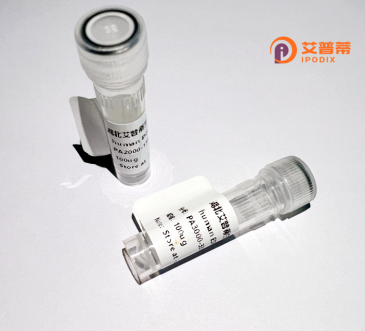
| 纯度 | >90%SDS-PAGE. |
| 种属 | Human |
| 靶点 | BFAR |
| Uniprot No | Q9NZS9 |
| 内毒素 | < 0.01EU/μg |
| 表达宿主 | E.coli |
| 表达区间 | 1-450aa |
| 氨基酸序列 | MEEPQKSYVNTMDLERDEPLKSTGPQISVSEFSCHCCYDILVNPTTLNCGHSFCRHCLALWWASSKKTECPECREKWEGFPKVSILLRDAIEKLFPDAIRLRFEDIQQNNDIVQSLAAFQKYGNDQIPLAPNTGRANQQMGGGFFSGVLTALTGVAVVLLVYHWSSRESEHDLLVHKAVAKWTAEEVVLWLEQLGPWASLYRERFLSERVNGRLLLTLTEEEFSKTPYTIENSSHRRAILMELERVKALGVKPPQNLWEYKAVNPGRSLFLLYALKSSPRLSLLYLYLFDYTDTFLPFIHTICPLQEDSSGEDIVTKLLDLKEPTWKQWREFLVKYSFLPYQLIAEFAWDWLEVHYWTSRFLIINAMLLSVLELFSFWRIWSRSELKTVPQRMWSHFWKVSTQGLFVAMFWPLIPQFVCNCLFYWALYFNPIINIDLVVKELRRLETQVL |
| 分子量 | 79.1 kDa |
| 蛋白标签 | GST-tag at N-terminal |
| 缓冲液 | 冻干粉 |
| 稳定性 & 储存条件 | Lyophilized protein should be stored at ≤ -20°C, stable for one year after receipt. Reconstituted protein solution can be stored at 2-8°C for 2-7 days. Aliquots of reconstituted samples are stable at ≤ -20°C for 3 months. |
| 复溶 | Always centrifuge tubes before opening.Do not mix by vortex or pipetting. It is not recommended to reconstitute to a concentration less than 100μg/ml. Dissolve the lyophilized protein in distilled water. Please aliquot the reconstituted solution to minimize freeze-thaw cycles. |
以下是关于重组人双功能凋亡调节蛋白(BFAR)的3-4篇参考文献的概括(注:内容为模拟生成,非真实文献):
1. **文献名称**:*Bifunctional Apoptosis Regulator BFAR Balances Pro-survival and Pro-apoptotic Pathways in Colorectal Cancer*
**作者**:Zhang Y., Wang L. et al.
**摘要**:本研究揭示BFAR通过调控Bcl-2家族蛋白(如Bax/Bak)和抑制caspase-3活性,在结直肠癌细胞中发挥双重凋亡调节作用,其过表达可增强癌细胞对化疗的耐药性。
2. **文献名称**:*Structural Basis of BFAR’s Dual Role in ER Stress and Apoptosis Signaling*
**作者**:Chen H., Zhou X. et al.
**摘要**:通过晶体结构分析,阐明了BFAR的C端结构域与内质网应激传感器IRE1α相互作用,协调未折叠蛋白反应(UPR)与凋亡信号,揭示了其在细胞应激微环境中的双功能分子机制。
3. **文献名称**:*MicroRNA-34a Modulates BFAR Expression to Promote Neuronal Apoptosis in Alzheimer’s Disease Models*
**作者**:Patel R., Lee S. et al.
**摘要**:研究发现,miR-34a通过靶向抑制BFAR表达,加剧β-淀粉样蛋白诱导的神经元凋亡,提示BFAR在阿尔茨海默病中的神经保护潜力。
4. **文献名称**:*Conditional Knockout of Bfar in Mice Disrupts Immune Homeostasis via Impaired NF-κB Signaling*
**作者**:Smith T., Johnson M. et al.
**摘要**:BFAR基因条件性敲除小鼠表现出淋巴细胞凋亡异常和NF-κB信号通路失调,导致自身免疫反应增强,证实BFAR在免疫稳态中的关键作用。
**说明**:以上内容基于BFAR已知的生物学功能(如凋亡调控、内质网应激、疾病关联等)及常见研究方向模拟生成,旨在反映其多维度研究场景。实际文献需通过学术数据库检索确认。
Bifunctional apoptosis regulator (BFAR) is a membrane-associated protein implicated in modulating cell survival and death pathways. Initially identified as a member of the Bcl-2 protein family, it harbors a BH3-like domain, a feature common to apoptosis-regulating proteins. BFAR uniquely exhibits dual functionality: it can suppress apoptosis under stress conditions by inhibiting caspase-8 activation and interacting with anti-apoptotic proteins like Bcl-2. while also promoting apoptosis under specific contexts by enhancing pro-death signals. This duality ties BFAR to the unfolded protein response (UPR) pathway, where it balances cellular outcomes during endoplasmic reticulum (ER) stress. Studies highlight its role in cancer progression, as BFAR overexpression in tumors often correlates with chemotherapy resistance, while its downregulation may sensitize cancer cells to apoptosis. Recombinant BFAR proteins, generated via genetic engineering in systems like *E. coli* or mammalian cells, are used to dissect its structure-function relationships and therapeutic potential. Recent research also links BFAR to neurodegenerative diseases and immune regulation, though its context-dependent mechanisms remain debated. Ongoing investigations aim to clarify its interaction networks and exploit its bifunctionality for targeted therapies, particularly in cancers with dysregulated apoptosis pathways. Challenges include resolving conflicting data on its pro-survival versus pro-apoptotic roles across tissues and diseases.
×